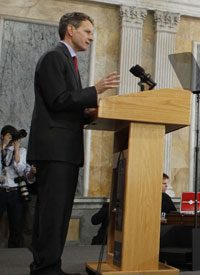
In point of fact, the system was “damaged” for decades, thanks to the distorting effects of an inflationary money system and the moral hazard created by years of unwise regulation of the markets and periodic bailouts of failed enterprises. Instead of “working against recovery,” the global financial system is trying to heal itself by expelling many years’ accumulation of aptly named “toxic assets” from the economic bloodstream. Like recovery from a bender or a long-term addiction, the pain of recession and bankruptcy is a necessary curative.
But Geithner and company have never seen things that way. In their view, the free market, while usually viable, sort of, sometimes fails spectacularly and needs coercive correction from the Powers That Be. In practical terms, that means doing everything necessary — printing any sum of money, raising any levy of taxes — to prevent the free market from correcting itself.
It means trying to reinflate the real estate bubble that everyone now, with the benefit of hindsight, recognizes as an absurdity. Yet more absurd will be the Fed’s efforts to “rescue” the mortgage markets, and in particular stave off the looming collapse of the commercial real estate market, by trying to prop up real estate values wherever possible.
The Fed announced today in conjunction with Geithner’s address that it is prepared to expand the funding available via the newly created Term Asset-Backed Securities Loan Facility (TALF) to $1 trillion. This latest brainchild of Fed Chairman Bernanke was announced last November, but has yet to commence operations. Like several other recent Fed creations, the TALF will extend loans for which a broad array of formerly inadmissible collateral — including mortgage-backed securities — may be pledged by those benefitting from the Fed’s credit.
Also in the mix to prop up the mortgage markets was a proposed $50 billion to assist homeowners in dealing with foreclosures.
Aside from the expansion of the not-yet-operational TALF, Geithner’s other headliner was a vague proposal to create a public-private partnership empowered to raise up to $500 billion to purchase nonperforming assets. Although the Treasury Secretary promised to use the lessons of financial crises throughout history as his guiding light, he probably ought to take a closer look at the Hoover administration. Herbert Hoover was besotted with public-private partnerships, and his very first effort to come to grips with the crisis that became the Great Depression was to create the National Credit Corporation (NCC), with a mandate for government to partner with private enterprise to raise $500 million to bail out foundering banks. Unfortunately for Hoover, private enterprise didn’t think much of the plan and, after only raising a fraction of the contemplated sum, Hoover gave up on the NCC.
As was the case in Hoover and Roosevelt’s day, so too in ours: every new government program will be paid for, one way or the other, by American taxpayers present and future. The $1 trillion that the Fed will have to manufacture to allow the TALF to function will be inflationary, resulting in steep devaluation of the dollar in the long run. The other programs, funded by taxes, will result in steep tax increases in coming years, and a return to the economic malaise of the ’70s, or perhaps even the ’30s.
In a word, everything the government is doing to try to prevent the economy from healing itself will make things worse — perhaps immeasurably so. Nor is all this in the remote future — the trillions of dollars of new debt that America is taking on cannot and will not be repaid, making national insolvency a very real and immediate possibility.
The economist Keynes and his epigones, who are responsible for the modern ideology of borrow, inflate, and spend as an economic cure-all, used to laugh at their detractors’ concerns over long-run consequences, pointing out that “in the long run, we are all dead.” True enough, but now that the Keynesian chickens are coming home to roost, it’s apposite to point out that, in the short run, we will all be bankrupt.
Photo: AP Images



